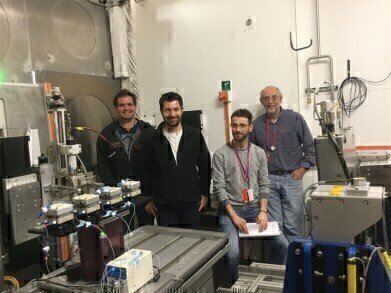-
 From left to right: Luke Clifton, Maximilian Skoda, Nicolo Paracini and Jeremy Lakey. (Credit: STFC)
From left to right: Luke Clifton, Maximilian Skoda, Nicolo Paracini and Jeremy Lakey. (Credit: STFC)
News
Scientists Provide Breakthrough on Bacterial Resistance
Aug 09 2018
World leading research carried out by scientists from Newcastle University and the UK's ISIS Neutron and Muon facility is increasing our understanding of how antibiotics treat bacteria. The team used a technique known as neutron reflectometry at STFC’s ISIS facility in Oxfordshire to examine how Polymyxin B, a last resort antibiotic, interacts with the outer membrane of Gram-negative bacteria. These hardy bacteria are responsible for life-threatening diseases like pneumonia and meningitis, making them key targets for clinical research.
Professor Jeremy Lakey, from the Institute for Cell and Molecular Biosciences at Newcastle University, said: “Most antibiotics currently used to kill Gram-negatives enter the bacteria via protein pores which can mutate to resist the drug. Polymyxin B kills bacteria by directly disrupting the outer membrane structure. Exploiting such different types of drug molecules is one strategy we can use to overcome the antibiotic resistance that has built up over the years.”
“Targeting the outer membrane offers alternative ways to kill pathogens and our new data shows us why bacteria are vulnerable to this type of attack. They need to keep their outer membrane flexible to grow but that provides the weakness exploited by the Polymyxin.”
Using an artificial model, created in 2013 at the ISIS Neutron and Muon Source, the scientists were able to mimic both the initial insertion and subsequent process by which the antibiotic disrupts the structure of the outer membrane and increases membrane permeability, leading to cell death.
Dr Luke Clifton, ISIS Neutron & Muon Source said: “The outer membrane of the Gram negative bacteria is the barrier between these microorganisms and their external environment. The models of this surface, which we have developed with our colleagues at Newcastle University, allow us to gain molecular level details on this barrier in conditions found in the living organism.
“Neutron science is key to these studies as neutrons are a highly adaptable, non-damaging probe of molecular structure which can differentiate between the different biomolecules found in these complex systems. This allows us to locate the individual components within the bio-membrane and examine how they change during the interaction of the antibiotic.”
The team now plan to investigate how bacteria develop resistance mechanisms against Polymyxin which will help in the design of second generation molecules, to use when Polymyxin itself becomes less effective.
Digital Edition
Lab Asia Dec 2025
December 2025
Chromatography Articles- Cutting-edge sample preparation tools help laboratories to stay ahead of the curveMass Spectrometry & Spectroscopy Articles- Unlocking the complexity of metabolomics: Pushi...
View all digital editions
Events
Jan 21 2026 Tokyo, Japan
Jan 28 2026 Tokyo, Japan
Jan 29 2026 New Delhi, India
Feb 07 2026 Boston, MA, USA
Asia Pharma Expo/Asia Lab Expo
Feb 12 2026 Dhaka, Bangladesh


















